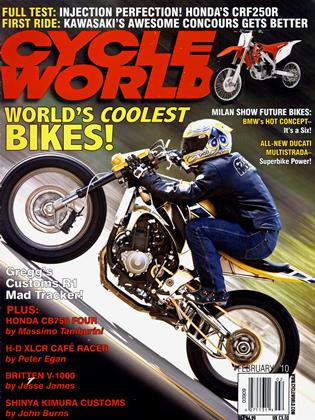2010 KAWASAKI CONCOURS 14
CW FIRST RIDE
The reigning king of sport-tourers gets even better yet
PAUL DEAN
IT ALREADY WAS A FABULOUS MOTORCYCLE. Bullet-train fast and luxury-car smooth, the 2008-09 Concours 14 offered openroad serenity rivaling that of big-rig tourers; yet on the backroads, that 647-pound sport-tourer somehow managed to handle almost as well as many pure sportbikes weighing a couple of hundred pounds less.
For 2010, Kawasaki has refined the big Concours into an even better sport-touring weapon, despite all of the bike’s primary ingredients—the 1352cc inline-Four engine with variable valve timing, six-speed overdrive transmission, four-link Tetra-Lever shaft drive and monocoque chassis—remaining entirely unchanged. The differences instead are in the support systems of this saddlebagged road rocket, improvements and additions that further broaden the appeal of the machine that garnered Cycle World's Best Sport-Touring Bike honors in both 2008 and 2009.
Among those upgrades are a 234-inch-taller electrically adjustable windscreen; heated handgrips; a storage compartment in the left fairing panel rather than atop the tank as on previous models; 40mm-higher mirrors for improved rear visibility and hand protection; and a redesigned fairing that significantly reduces the amount of engine-heated air that reaches the rider.
As before, the 14 is available in either ABS ($15,299) or non-ABS ($14,599) models. If you choose the former, you get the second-generation version of Kawasaki’s K-ACT linked anti-lock braking arrangement, as well as KTRC, the company’s first-ever true traction-control system. KTRC employs cuts in intake airflow, ignition timing and fuel delivery to prevent wheelspin, while K-ACT offers two modes of linked braking performance. The front-to-rear linked effect is the same in both modes when squeezing the hand lever, adding just enough rear brake to help keep the chassis settled. But when you push on the foot pedal, Standard Mode delivers full rear braking along with a barely detectable amount of front brake; in High Combined Mode, rear-brake use results in considerable frontbrake application.
For sport riding, I found Standard Mode to be the more desirable. It seemed entirely unobtrusive during fast backroading, even when trail-braking while banking over into corners. The High Combined Mode, though, delivered too much front brake for my tastes, sometimes resulting in enough front-end dive to upset the chassis. But I understand how that mode, working in concert with the anti-lock system, could prove valuable in a panic stop.
I was able to give the anti-lock system a very convincing test during the new C14’s press introduction held at Indian Wells, California. Kawasaki had an outrigger-equipped Concours on hand, along with a temporary “skid pad” composed of big sheets of water-covered plastic. Simultaneously grabbing a handful of front brake and mashing the rear pedal on the slippery-as-ice surface always resulted in straight, drama-free stops with only the slightest bit of rapid-frequency pulsing felt at the lever and pedal. And unless I did something stupid with the handlebars, the outriggers never touched the ground.
I also experienced the KTRC traction-control system’s full potential on the skid pad. With KTRC turned off, even thinking about opening the throttle on the watered-down plastic resulted in wild slides and uncontrolled wheelspin; but with the system turned on, I could not make the rear tire spin in any gear or at any rpm, regardless of how far I opened the throttle.
That’s quite impressive considering the Concours’ prodigious power output. Because the engine is unchanged for 2010, it performs just as admirably as before, delivering smooth, sneaky-fast, never-ending power that is awesome to behold, and the handling still is a marvel of agility in the face of sheer mass. The 14 does come with a new front tire for 2010 that renders the steering slightly more neutral, and a higher level of oil in the fork reduces front-end dive during hard braking. But the net effect remains unchanged: Every time you wick open the throttle or bend into a comer on this magical GT express, you get the irresistible urge to do it again.. .and again.. .and again.
So, yes, the improvements in this 2010 model may seem small, but they nonetheless are unlikely to help the competition unseat the Concours 14 as the world’s best sport-touring motorcycle.
 View Full Issue
View Full Issue
More From This Issue
-
 Up Front
Up FrontSeizing the Means of Production
FEBRUARY 2010 By Mark Hoyer -
 Roundup
RoundupSexysix
FEBRUARY 2010 By Bruno Deprato -
 Roundup
RoundupKiller Concepts
FEBRUARY 2010 By Bruno Deprato -
 Roundup
Roundup2010 Mv Agusta F4
FEBRUARY 2010 By Bruno Deprato -
 Roundup
RoundupKtm Concept 125 Supermoto Racers
FEBRUARY 2010 By Bruno Deprato -
 Roundup
RoundupBetter Boxers
FEBRUARY 2010 By Bruno Deprato










